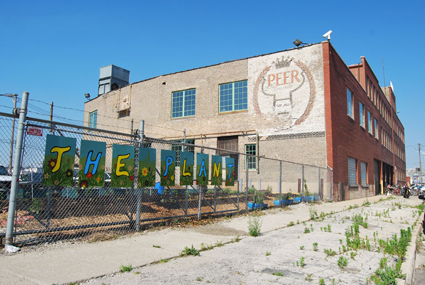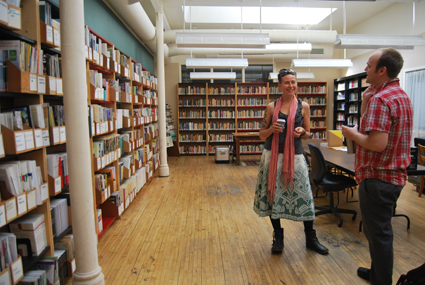the ari tour: part 1: chicago
rebecca conroy: exploring american artist-run spaces

The Plant, Chicago
photo Tessa Zettel
The Plant, Chicago
IN MAY 2012 I EMBARKED ON A FOUR-MONTH TOUR OF NORTH AMERICAN ARTIST-LED SPACES AND INITIATIVES ACROSS 14 CITIES. BY CONNECTING WITH THESE SPACES AND CITIES, I HOPED TO LEARN ABOUT DIFFERENT MODELS AND THE CONTEXTS SHAPING THEM, AND TAKE A COMPARATIVE LOOK AT OUR OWN SITUATION IN AUSTRALIA, SPECIFICALLY SYDNEY.
The tour was also an opportunity to ponder the behaviour of cities, and the potential for artist-led activity to transform economies. As director of Bill+George, an ARI in Redfern, I also hoped to start a conversation with various spaces on a possible collaborative exchange project for 2014.
The artist-run initiative (ARI), the artist-run space, or the artist-run centre (ARC) as it is known in Canada, is a useful barometer for the health of the arts and the political economy in general. In Australia, the ARI can be considered an incubator for new ideas, with a reputation for risk and experimentation, and a drawcard for emerging artists in the first few years of their practice. Conventional definitions in Australia typically assume a predominantly visual art frame, with some kind of curatorial or exhibition activity.
definitions & ideologies
I have observed for a while the need for an expanded definition of the Artist-Run Initiative in Australia because current definitions omit a large swathe of artist-led activity which is actively contributing to and enhancing artistic output, and the capacity for artists to innovate new forms and ideas. Current discourse and definitions are narrow in reach, and tend to elide the substratum network of what all artist-led activity does, which is to connect at the creative level what everyone in the non-creative world does: manage, administer, make business decisions and produce and distribute resources in order to keep their enterprise going. In particular, scant attention is paid to the effects of autonomous decision-making on artistic endeavours, and the flow-on effects of self-organisation, which strengthen the artist’s political muscle in the broader economy.
Coming to America, I was intrigued by the ‘pulling yourself up by the bootstraps’ mentality and the entrepreneurial flag-waving which sit awkwardly alongside America’s difficult relationship to ‘big government’ and public funding. I was interested in how these ideologies were shaping artistic endeavour. Over the course of the journey my line of inquiry grew to include housing projects, publishing endeavours, libraries, urban farms, breweries, small manufacturers and even an artist-run limousine service.
building a hot list
My initial plan reflected a hot list of happening spaces and connected people. A great resource for building a list is the Phone Book, a solid listing of artist-run spaces and initiatives produced annually by Chicago artist-run gallery threewalls. In Canada, a comprehensive guide is the Directory of Artist-Run Centres published through Réseau Art Actuel by the Quebec-based regional association Le Regroupment des centres d’artistes autogeres du Quebec.
Time permitted a cursory drift through only a select number of regions, with this short review presenting a snapshot of three cities in the Mid West: Minneapolis/St Paul, Chicago and Detroit. In this edition I focus on Chicago.
chicago
My interest in exploring the USA was first ignited when I came across the Chicago-based venture Incubate. Describing itself as a research institute, the central thrust of Incubate is to explore new approaches to arts administration and funding, and to approach art administration much like a creative practice. Incubate is perhaps best known for Sunday Soup, a food-based micro-grant program which involves groups (artists or community) presenting short projects they want funded to a crowd who dine on soup cooked by volunteers. Audiences then vote on their favourite, with the winning project getting all the proceeds from the door. This concept has expanded internationally, and in January this year included Sydney’s favourite ARI, The Red Rattler, hosting one at their Marrickville venue.
In Chicago, artist-run spaces are plentiful in a city of more than 10 million, and a large number are havens for post-MFA artists looking for alternatives to the art market. Threewalls, an artist-run space located amongst a cluster of galleries in the arts district of Chicago’s West Loop, mixes a number of clever strategies. Mimicking the increasingly popular Community Supported Agriculture (CSA) programs across America, threewalls produces a twice yearly art subscription service of locally produced work, which they call Community Supported Art. Perhaps because of this, they are the only artist-run space invited to be part of the Expo, a Chicago Art Fair, presumably to help grease the trapdoor for emerging talent into the art market. Along with the Phone Book and initiatives across North America, threewalls also organises an annual conference called Hand in Glove which brings together artists from all over the country to talk about new ways of doing things with administration and project management.
Further south of the city in the Bridgeport neighbourhood, Co-prosperity Sphere takes up an impressive footprint in a still semi-industrial area with a receding reputation for seediness. Headed up by the affable enabler Ed Marszewski, Co-Prosperity is an exhibition space, a performance venue, a publishing arm, a festival platform, a craft beer maker and Small Manufacturing Alliance among many other things. It is also home to the annual Versionfest, an artist-run festival which basically remixes the neighbourhood, packing 60-plus events and happenings into 20 spaces for the month of May. Bringing together “cultural workers, community developers, urban entrepreneurs, artists, designers, foodies, public space hackers, urban planners, cultural geographers and dreamers” it presents the optimum conditions for expanding the artist-led realm.

Rebecca Conroy with Daniel Tucker, AREA Chicago
photo Tessa Zettel
Rebecca Conroy with Daniel Tucker, AREA Chicago
Marszewski refers to Bridgeport and Co-prosperity as the “Community of the Future” and has been promoting its wares through a number of very nicely designed and printed publications. He considers the community newsletter to be an excellent instrument for building community and activating its histories. Similarly, histories and local archives drive the work of Chicago artist Daniel Tucker, a prolific maker of projects who has an extensive archive of Chicago art and community projects. He describes one such project, AREA Chicago, which he founded in 2005, as “a print publication, a web platform, an event series and a group learning experiment for adults who identify as artists, researchers, educators and activists living in the city of Chicago” (AREA Chicago, The First Five Years #12). AREA is published twice a year on a theme decided by the editorial team who often provisionally attach themselves to other organisations or sites to inform the curatorial and editorial process. This makes for a nimble publishing endeavour, engaging various communities through physical proximity.
Tucker is currently working with Rebecca Zorach on Never-the-Same.org, an online archive about social and political art in Chicago and a wonderful resource for those new to Chicago as much as it must be for those who share its history. Tucker is also involved in Compass, a loose alliance of artists, critical thinkers, researchers from an area they refer to as the Mid West Radical Culture Corridor, and who have just published a collection of work called Deep Routes: The Midwest in all Directions (White Wire, Wisconsin, 2012). The text pulls together a survey of regional encounters within the Midwest and beyond, highlighting knowledge production and the economic reality of communities from the perspective of specific locations and sites.
In Back of the Yards, another neighbourhood south of the city, The Plant is a vertical farm and sustainable food business inside a repurposed meatpacking facility measuring 45,000 square feet. Industrial artist and designer John Edel purchased the building in 2010 having previously run Bubbly Dynamics, an industrial arts and sustainable manufacturing centre. Operating as a social enterprise and not for profit organisation, The Plant is working towards zero net waste and zero net energy status. Here, as in many artist-led spaces and ventures, The Plant recognises the need for deep connection with local community; every two weeks it holds an open day and tour of the facility, promoting the practice of zero net waste and energy, as well as animating the place and bringing business to the enterprise.
Crucial to this project, and to many artist led projects across the States is access to affordable property. And although the familiar dirge of artist led gentrification shadows the artist run enterprise wherever it goes, the boom and bust cycle means it is currently straddling a fertile cusp. The call of the urban artist pioneer for renewing and revitalising is nigh. Detroit is a case in point, magnified to the power of a thousand, and in many ways provided an anchor to this trip, as you’ll read in RealTime 112.
In RealTime 112, Rebecca Conroy encounters unexpected artist-run initiatives in Detroit, Minneapolis and St Paul, including a car service, a traffic calming initiative and an artist business incubator.
See also Rebecca Conroy’s Detroit RT Traveller
RealTime issue #111 Oct-Nov 2012 pg. 53






